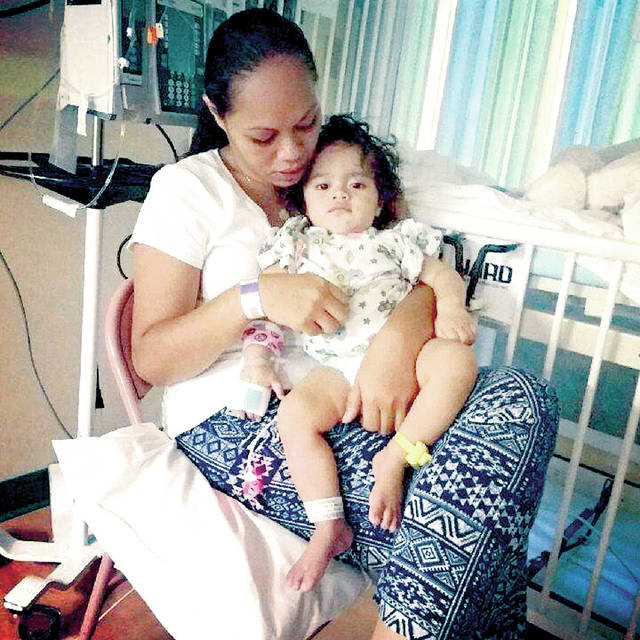The latest victim of rat lungworm disease in the state is a Pahoa infant thought to have eaten a slug or snail.
Eleven-month-old Kanehekili “Kane” Tauanuu’s parents, Santini and Dylan Tauanuu, said via a social media interview that their son is “slowly getting better each day.” But he is expected to remain hospitalized until he relearns how to crawl and can hold himself up again.
Rat lungworm can occur when rat droppings containing larvae are eaten by snails or slugs. When a human accidentally eats those snails or slugs, the parasites travel to the brain, causing neurological symptoms.
The state Department of Health announced Wednesday that a Pahoa infant — presumed to be Kane — was confirmed to have rat lungworm disease, the 17th person in the state this year and the 10th from the Big Island.
Kane is receiving care at Kapiolani Medical Center for Women and Children in Honolulu. His parents said he was taken there on a medevac flight Sept. 16. They’re frustrated at how long Kane’s diagnosis took — and that his mother had to demand rat lungworm testing, a common complaint among patients eventually diagnosed.
“It took nine days, two ER visits, one Urgent Care visit and two pediatric visits before they finally took a blood sample at the ER in Hilo,” Kane’s mother said. “I was turned away multiple times and told he just had a cold and was given Motrin for his high fevers. I almost got turned away again but I demanded the hospital draw blood samples and do tests.”
There are reasons diagnoses get delayed.
Dr. Jon Martell, Hilo Medical Center medical director for Acute Care, said he can’t speak about specific cases. But he said pediatric symptoms are “practically indistinguishable” from common childhood illness symptoms such as fever, chills, lethargy, nausea and vomiting.
Another problem is that there still is no quick, reliable blood test to diagnose rat lungworm.
In general, “requests for rat lungworm testing need to be evaluated by physicians on a case-by-case basis,” he said. The need to test depends on things such as exposure likelihood, symptoms and physical findings.
A blood test for white blood cell count is simple, but isn’t definitive, Martell said. Getting a definitive answer requires a spinal tap, “which is an invasive procedure with a very small but real risk of side effects and complications.”
Santini Tauanuu wants other parents to pay attention to what happened to her family.
“If they would have just listened to me the first time when I initially took him to the ER on (Sept. 8), he would have gotten help a lot sooner,” she said.
The DOH set rat traps near the family’s home and discovered snails under a neighbor’s tarp during its investigation, she said.
Her advice for other parents includes “watch for high fevers, loss of appetite, less body movement, stiff neck and diarrhea.” Those are symptoms Kane exhibited.
Santini Tauanuu also advises parents not to allow health providers to turn them away if they suspect rat lungworm.
“Trust your gut instinct,” she said.
State health officials said they want all parents and caregivers of young children and infants to take “extra precautions” to make sure kids don’t ingest rat lungworm larvae.
The DOH recommends parents and caregivers:
• Watch infants, toddlers and children carefully while they are playing and make sure they are not picking up slugs, snails or other objects from the ground and putting those into their mouths.
• Help children properly wash their hands after playing and/or being on the ground. Use running water and soap.
• Close and seal food and beverage containers when not in use to prevent slugs and snails from crawling inside, especially when left on or near the ground.
“I cannot emphasize strongly enough the necessity for everyone to use measures to avoid this potentially debilitating, yet highly preventable disease,” Martell said via email. “Control rats around your property by controlling sources of food for rats (garbage, chicken feed, pet food, etc.). Control snails and slugs by eliminating leaf litter, garbage, etc. Use pet-safe traps and poisons.”
He advises inspecting vegetables “thoroughly” and discard “anything suspicious.”
“Cooked veggies and veggies that can be peeled are generally safe,” Martell said.
Martell also advises vector control around catchment tanks and said “do not use catchment water for drinking unless boiled first.”
Santini Tauanuu expressed appreciation for prayers and best wishes.
“This is a sad, unfortunate situation that I wouldn’t want any other child or family to have to go through,” she said.
Email Jeff Hansel at jhansel@hawaiitribune-herald.com.






